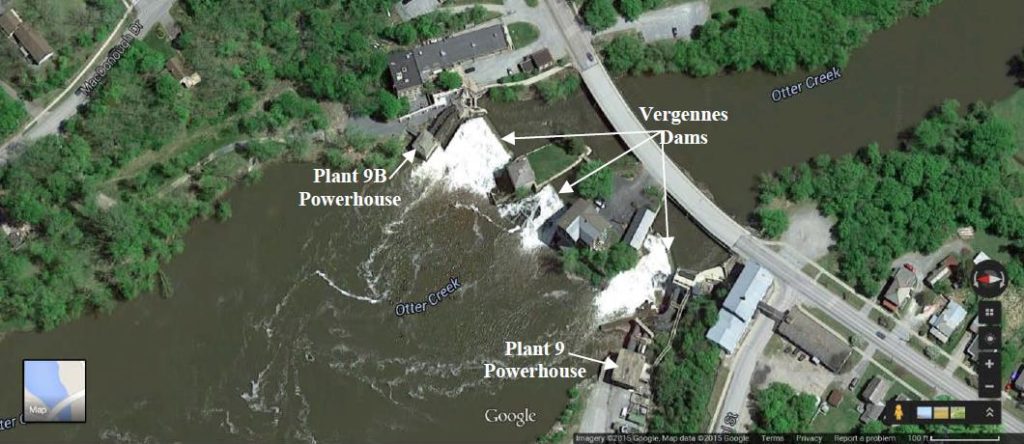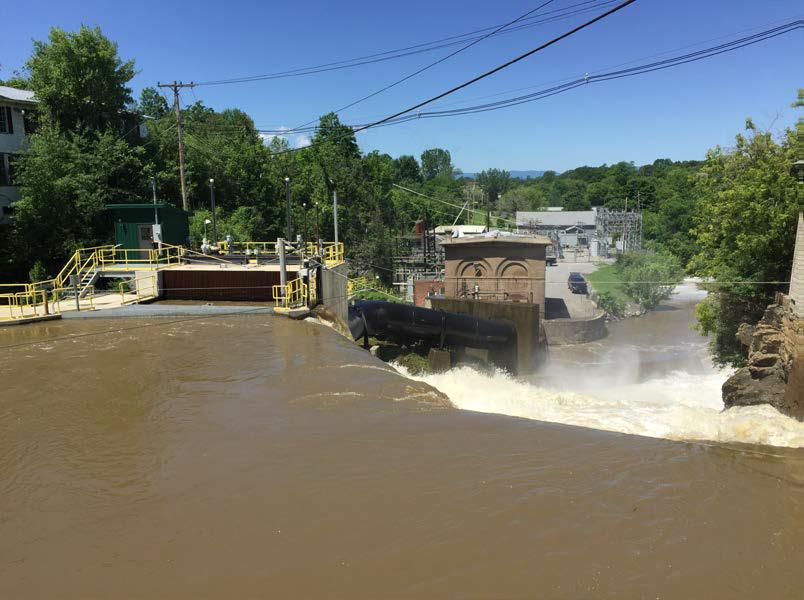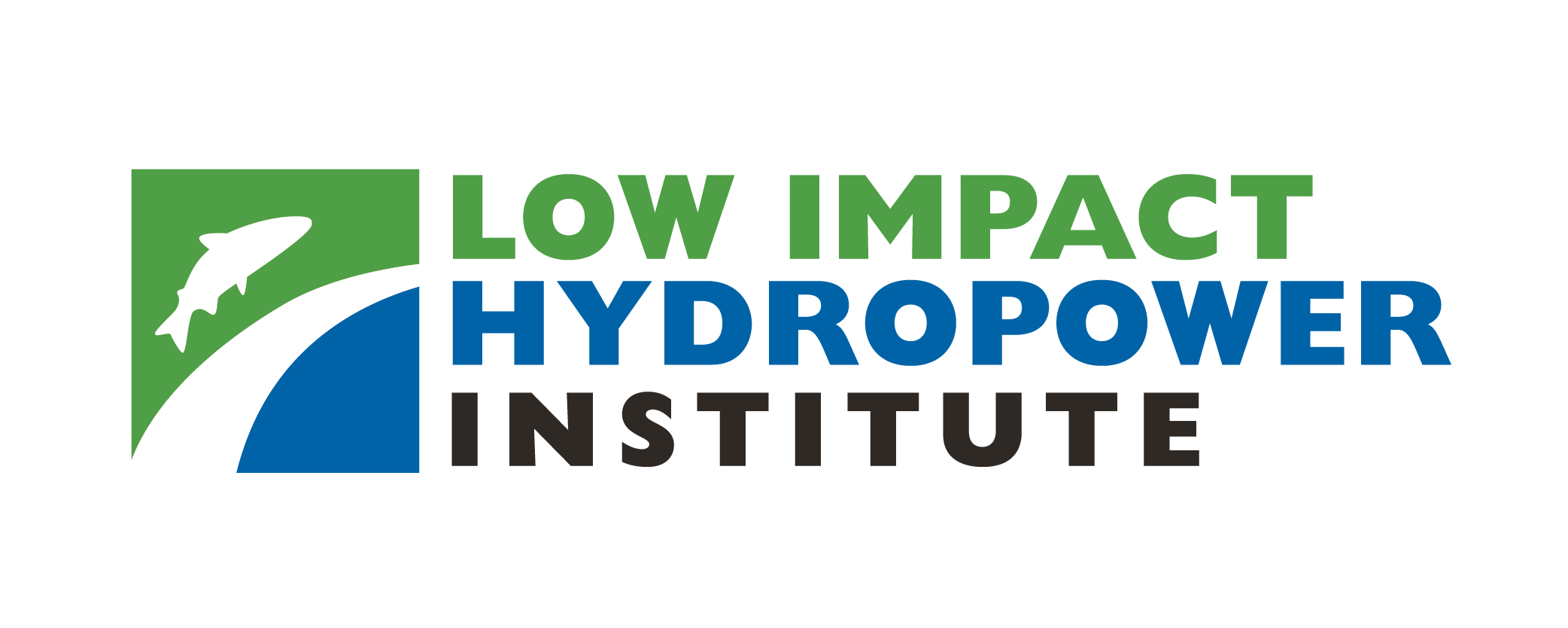LIHI Certificate #134 – Vergennes Project, Vermont



| Project Name | Vergennes |
| LIHI Certificate No. | 134 |
| LIHI Certificate Term |
December 30, 2021 – December 29, 2031 |
| Owner | Green Mountain Power Corporation |
| State | Vermont |
| Location | Located on Otter Creek, a tributary to Lake Champlain, at river mile 7.6, in Vermont. |
| Installed Capacity | 2.6 MW |
| Average Annual Generation | 14,144 MWh |
| Facility Type | Run-of-river |
| FERC No. | P-2674 issued in 1999, expires 05/31/2029 |
The Vergennes Project is located on Otter Creek in Addison County, Vermont. Otter Creek originates in East Dorset, Vermont, extends approximately 100 miles to Lake Champlain, and its basin has a total drainage area of about 936 miles.
The project is situated at natural rock falls and Lake Champlain backwaters to the tailrace. Electric power has been generated from Vergennes Falls since 1896. The current facilities of the Vergennes Hydroelectric Project were originally constructed between 1911 and 1943 and underwent a significant number of changes to enhance environmental performance, most notably the conversion from a daily peaking plant to run-of-river operation. The project is the first dam on the river and located downstream of the Weybridge Project (LIHI #98). Other upstream projects include Middlebury Lower (LIHI #99) and Otter Creek (LIHI #128). The project is owned by Green Mountain Power (GMP), the first energy utility certified as a B-Corporation.
Electric power has been generated from Vergennes Falls since 1896. The current project facilities of the were originally constructed between 1911 and 1943 and underwent a significant number of changes to enhance environmental performance, most notably the conversion from daily peaking to run-of-river operation in 1999.
The project includes two powerhouses – Plant 9 located on the south bank of Otter Creek and Plant 9B located on the north bank. The two powerhouses are separated by three concrete spillway sections that are divided by two instream islands and one 29-foot-long non-overflow dam. The dam is topped with 1.5-foot-high timber flashboards. Center Island divides the Plant 9B spillway from the center spillway and Grist Mill Island divides the center spillway from the Plant 9 spillway. Each of the spillways are approximately 10 feet high, with a total length of 231 feet. Plant 9B contains one steel penstock and Plant 9 contains two steel penstocks. Each powerhouse includes a forebay with trashracks and head gates.
The Plant 9B station was originally constructed in 1943 and contains one vertical Francis turbine directly connected to a generator. The Plant 9 powerhouse was constructed in 1911 and contains two double discharge Francis turbines installed in 2005-2007. The new modem design units increase plant efficiency with a moderate increase (13 cfs) in hydraulic capacity.
The project operates in a strict run-of-river mode and impounds a 133-acre reservoir. The dam structures create three short bypassed reaches no more than 150 feet long. Flows over the spillways support aesthetics and recreation with the following flow schedule: from April 1- October 31, 150 cfs during daytime and 75 cfs at night. From November 1-December 15, 100 cfs during daytime and 50 cfs at night. From December 16 – March 31 there are no specific flow requirements. Flow levels were developed from a demonstration study in consultation with the Vermont Agency of Natural Resources (VANR).
Waters within the project reach are designated as Class B and support aquatic biota, habitat, and plant life. Downstream waters are impaired for contact recreation and fish consumption. The impairment is not caused by project operations, but rather due to overflows of wastewater treatment plant pump stations (E. coli) and mercury from atmospheric deposition. The consistent impoundment levels, minimum bypass flows, and run-of-river operations minimize Project impacts on water quality.
Otter Creek supports a fishery and spawning habitat for landlocked Atlantic salmon, lake sturgeon, and walleye. VANR stocks walleye and Atlantic salmon in lower Otter Creek and these species use areas downstream of the project as spawning habitat. Largemouth bass, smallmouth bass, northern pike, walleye, chain pickerel, yellow perch, brown and rainbow trout, sunfish species, and a variety of minnows are also present. Fish passage facilities have not been prescribed by agencies at the project and the natural falls preclude upstream migration. Plant 9’s intake is equipped with trashracks with 1-inch clear spacing while Plant 9B’s intake is equipped with 2-inch clear spacing between bars. The project provides seasonal flows over the dam to aid in the protection and preservation of fish populations: April 1 – June 15 for Atlantic salmon and walleye and September 15 – November 15 for lake sturgeon.
The project property consists of 7 acres of land and approximately 133 acres of water. There are no lands of significant ecological value in the project area. Surrounding land consists of areas of low, medium, and high intensity development, developed open space, deciduous forest, evergreen forest, mixed forest, woody wetlands, and open water. Mixed industrial, and commercial buildings, and housing are spaced on both sides of the river within the City of Vergennes. Run-of-river operations and consistent impoundment water surface elevations minimize the potential for the Project to negatively affect the shoreline.
Threatened and endangered species potentially within project vicinity include Northern long-eared bat, Indiana bat, lake sturgeon, black sandshell, fragile papershell, pink heelsplitter, pocketbook mussel, giant floater, fluted-shell, green dragon, mudpuppy, silvery lamprey, eastern sand darter, channel darter, silver redhorse, creeping love-grass, three-parted beggar’s ticks, and red-root flat-sedge. Project operations do not have negative impacts on the listed species. Seasonal flows provide protection of lake sturgeon and run-of-river operations mitigate impacts to mussel populations. Tree cutting is typically not required. VANR and US Fish and Wildlife Service confirmed project operations do not negatively affect the listed bat species and plant species.
The project is located within the Vergennes Historic District, listed in the National Register of Historic Places . The boundary of the historic district encompasses the entire complex of buildings and structures of the Vergennes Project. The penstocks and headworks structure are historically significant as contributing components of the Vergennes Project as are Norton’s Grist Mill and a historic pump house both constructed in the late 1800s. The project operates under a Cultural Resources Management Plan developed in coordination with the Vermont Division for Historic Preservation (VDHP). The project owner reports annually on activities conducted and consults with VDHP prior to construction-related activites.
Recreational resources at the project include a boat ramp, portage routes, picnic areas, and interpretative signage. The project’s recreation plan was developed to provide improved boat access, parking, portage routes, picnic tables, and landscaping improvements. Public access is provided free of charge.
Compliance Status
The Certificate includes the following facility-specific condition:
Condition 1: The facility Owner shall confirm submittal of operations data as requested by Vermont DEC within 60 days of the submittal. In annual compliance statements to LIHI, until the agency has concurred that facility operations continue to meet WQC requirements, the Owner shall provide an update on the status of this review and copies of all operations data related agency correspondence.
2024: No material changes or compliance issues were identified. The project remains in compliance based on the annual review. For Condition 1, the project reported that operations data was provided in the relicensing PAD filed May 1, 2024.
2023: No material changes or compliance issues were identified. The project remains in compliance based on the annual review. For Condition 1, the project reported that 2023 operations data will be provided in relicensing PAD to be filed in early 2024.
2022: No material changes or compliance issues were identified. The project remains in compliance based on the annual review. For Condition 1, the project reported that 2022 operations data will be submitted in early 2023.
2021: Annual reporting for the current Certificate has not yet taken effect.
Certification History
August 1, 2022: The Low Impact Hydropower Institute has issued a final decision on the recertification of the Vergennes Project. The 30-day appeal window closed on July 21, 2022 and no appeals were filed. Therefore, the decision to recertify the project is now final. The new term is December 30, 2021 through December 29, 2031 in accordance with the term extension that became effective January 1, 2022 in Revision 2.05 of the LIHI 2nd Edition Certification Handbook.
June 21, 2022: The Low Impact Hydropower Institute (LIHI) has preliminarily approved the Vergennes Project (LIHI #134) for a new 10-year term of Low Impact Certification. The application and reviewer report can be found below. This decision is preliminary pending the 30-day appeal window. Only those who commented on the initial application during the 60-day comment period are eligible to file an appeal. Such appeal needs to include an explanation as to how the Project does not meet the LIHI criteria. Appeal requests can be submitted by email to comments@lowimpacthydro.org with “Vergennes Project” in the subject line, or by mail addressed to the Low Impact Hydropower Institute, 1167 Massachusetts Ave, Office 407, Arlington, MA 02476. All requests will be posted to the website. The applicant will have an opportunity to respond and any response will also be posted. Requests must be received by 5 pm Eastern time on July 21, 2022. If no appeal requests are received and the decision becomes final, the Certification term for the Project will be December 30, 2021 through December 29, 2031.
April 6, 2022: The Low Impact Hydropower Institute (LIHI) has received a complete recertification application from Green Mountain Power Corporation for the Vergennes Project. The complete application can be found below. LIHI is seeking comment on this application. Comments that are directly tied to specific LIHI criteria (flows, water quality, fish passage, etc.) will be most helpful, but all comments will be considered. Comments may be submitted to LIHI by e-mail at comments@lowimpacthydro.org with “Vergennes Project Comments” in the subject line, or by mail addressed to the Low Impact Hydropower Institute, 1167 Massachusetts Avenue, Office 407, Arlington, MA 02476. Comments must be received at the Institute on or before 5 pm Eastern time on June 5, 2022 to be considered. All comments will be posted to the web site and the applicant will have an opportunity to respond. Any response will also be posted.
June 20, 2017: Having received no requests for appeal, the Vergennes Hydroelectric Project received a final decision on June 8th that the facility satisfies the LIHI Certification Criteria. The certificate includes the following condition:
- Satisfied 2020. Condition 1. The owner shall consult with the Vermont Department of Environmental Conservation to determine appropriate procedures to verify Run-of-River (RoR) operations at the Vergennes facility. Within 180 days after certification, the owner shall provide LIHI with documentation describing the agreed-upon procedures and then implement those procedures within the first year of LIHI certification. In the first annual compliance report to LIHI, the owner shall summarize the initial results from RoR verification. If RoR verification activities continue beyond the first year of certification, then the owner shall report on the results annually.
May 8, 2017: LIHI Executive Director Shannon Ames announced a Preliminary Certification Decision that the Vergennes Hydroelectric Project (FERC No. P-2674) satisfies the LIHI Certification Criteria. As provided for in Section 4.2.5 of the LIHI 2nd Edition Handbook, the Preliminary Certification Decision, along with the Application Reviewer’s report and (if prepared) report of the Executive Director, will be posted on the Institute’s Web page for 30 days. Notice of the posting will be provided to all individuals or organizations that commented on the initial Application Package. Any Commenter may submit a letter to the Executive Director requesting an appeal within the 30-day period which ends on June 8, 2017. The appeal request must state specific reasons why the hydropower facility should have failed one or more criteria. Only individuals or organizations that commented on the initial Application Package may file an appeal. If no appeal is requested within the 30-day period, the Executive Director will issue LIHI Certification for the facility and post a notification of certification on the Institute’s website. Once final, the effective certification date for the Vergennes Project is December 30, 2016 for a five (5) year term, which will expire on December 30, 2021.
January 6, 2016: On December 30, 2016, the Low Impact Hydropower Institute (LIHI) received a complete application from Green Mountain Power Corporation for the Low Impact Certification of the Vergennes hydroelectric project, located on Otter Creek, a tributary to Lake Champlain, at river mile 7.6 in Vermont. LIHI is seeking public comment on this application. Specifically, we are interested in knowing whether you think the Vergennes project meets the LIHI Low Impact Certification Criteria. The Vergennes application is subject to review using the Criteria in the LIHI Certification Handbook of 2014. Please review the program and criteria in LIHI’s 2014 Handbook and then review the Project’s 2016 application materials posted on the project page. Comments that are directly tied to specific LIHI criteria (flows, water quality, fish passage, etc.) will be most helpful, but all comments will be considered. Comments may be submitted to the Institute by e-mail at comments@lowimpacthydro.org with “Vergennes Project Comments” in the subject line, or by mail addressed to the Low Impact Hydropower Institute, PO Box 194, Harrington Park, New Jersey 07640. Comments must be received at the Institute on or before 5 pm Eastern time on March 12, 2017 to be considered. All comments will be posted to the web site and the applicant will have an opportunity to respond. Any response will also be posted.
Certification Files
2022 Recertification
2017 Certification
- Vergennes Certification Reviewers Report 2017
- Vergennes Certification Application Vergennes 2016
- Strategic Plan for Lake Champlain Fisheries 2010
